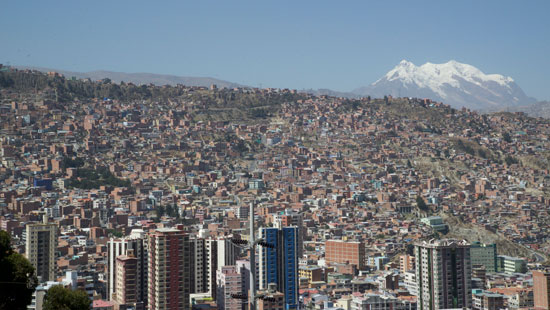
Unforgettable South America: Cultures of Peru & Bolivia

February 23, 2018
5 minute read
Newly-launched, Collette's Cultures of Peru & Bolivia tour promises an unforgettable fortnight of travels in South America. As you experience this enthralling continent on myriad modes of transport - from coaches, planes and trains to cable cars, boats and jeeps - you'll find an intoxicating blend of natural beauty and archaeological wonders, exotic indigenous customs and Spanish colonial heritage. This is one of Collette's special Explorations tours, so you can expect an average of just 18 guests per group, making the experience even more intimate.
Lima
Dubbed 'The City of Kings', the buzzy Peruvian capital was founded by the Spanish conquistadors in AD1535 and a tour of its UNESCO World Heritage-listed historic centre reveals a wealth of glorious colonial plazas and buildings, including Lima cathedral, the catacomb-laced San Francisco Monastery and the Archbishop's Palace, from whose wooden balcony you'll watch the changing of the guard at the neighbouring presidential palace. You'll also rub shoulders with Limenos in the fashionable suburbs of San Isidro and Miraflores, and browse precious artefacts dating back over 3000 years at the Larco Museum, which was built on the site of a pre-Colombian temple. During a welcome dinner at the museum, you'll discover why Peruvian cuisine is ranked the best in South America. Bursting with flavour, it's infused with fresh ingredients and European, Andean, Amazonian and Asian-Pacific influences.
Sacred Valley of the Incas
Leaving Lima and its Pacific Ocean setting behind, you'll fly into the Andes for some memorable encounters with the Quechua people, who are direct descendants of the Incas, and have had roots in these mountains stretching back thousands of years. In a region known as The Sacred Valley of the Incas, you'll learn about the locals' age-old methods of harvesting and crop-growing and how they spin, dye and weave textiles. You can fossick for knitted Quechua wares at the atmospheric handicraft market in the village of Pisac, and tuck into a farm-to-table lunch at a hacienda, where you'll be entertained by a Paso show, featuring a unique breed of horse brought to Peru by the Spanish. Enjoy craft beer? You'll like Sacred Valley Brewing Company, a non-profit brewery established to support a local orphanage.
Cusco and Machu Picchu
You'll see heaps of awe-inspiring relics of the Inca Empire, including the ruins of Ollantaytambo and the Sacsayhuaman fortress overlooking Cusco, a charming city studded with magnificent old buildings (including Hotel Aranwa Cusco Boutique, which occupies a 16th century colonial mansion, and is your cosy home for two nights). The most incredible Inca site of all, however, is Machu Picchu. Travelling aboard the Vistadrome train from Cusco, you'll enjoy jaw-dropping Andean views through the domed windows, before joining an expert guide for a walk around the ruins at Machu Picchu, which is spectacularly surrounded by forest-clad peaks. You'll stay overnight nearby, so set your alarm and watch the sun rise over this fabled 'Lost City of the Incas', which was constructed in the 15th century, abandoned soon after and 'rediscovered' in 1911.
Lake Titicaca
This spellbinding lake, which sprawls across the borders of Peru and Bolivia, is not only one of South America's most Insta-worthy places, it's also one of its most culturally-significant. Cruise over to Isla del Sol (Sun Island), said to be the birthplace of the Inca Empire. Hear Inca myths and legends as you climb the island's ancient steps, walk along its agricultural terraces, experience a shaman blessing session on a cliff top, and sail on an authentic reed vessel. As well as visiting the rustic lake-side towns of Puno and Copacabana, you'll meet the Uros people, who reside on Titicaca's 'floating islands' (basically cobbled-together beds of totora reeds). As you amble on the islands' spongy surface, you'll discover more about the Uros' traditions, folklore and way of life.
La Paz
The highest capital city in the world, perched in a steep-sided bowl 3640m above sea level, La Paz is a breath-taking feast for the senses. Shop for potions and medicinal plants at the eclectic Witches' Market, explore hilly cobbled streets and museums dripping with gold, dine at restaurants showcasing Bolivian fusion cuisine, and take an exhilarating cable car ride high above this bustling metropolis. Outside La Paz, you'll marvel at the weird and wonderful geological formations of Moon Valley, which was apparently named by Neil Armstrong, who likened the area to the lunar landscape that he became acquainted with in 1969.
Uyuni Salt Flats
If you think Moon Valley is surreal, wait til you're riding in a 4 x 4 jeep, picnicking and posing for photos on the dazzling white salt flats of Uyuni. The world's largest expanse of salt, it stretches farther than the eye can see and is studded with quirky sights, including an island of cacti that dates back millennia, and a hotel comprised of salt blocks (you'll bed down here for a couple of nights). Whilst you'll be mesmerised by the salt flats, you should look up too, especially after sunset. Thanks to its high altitude, low light pollution and clear skies, this is one of the best places on the planet for stargazing.
